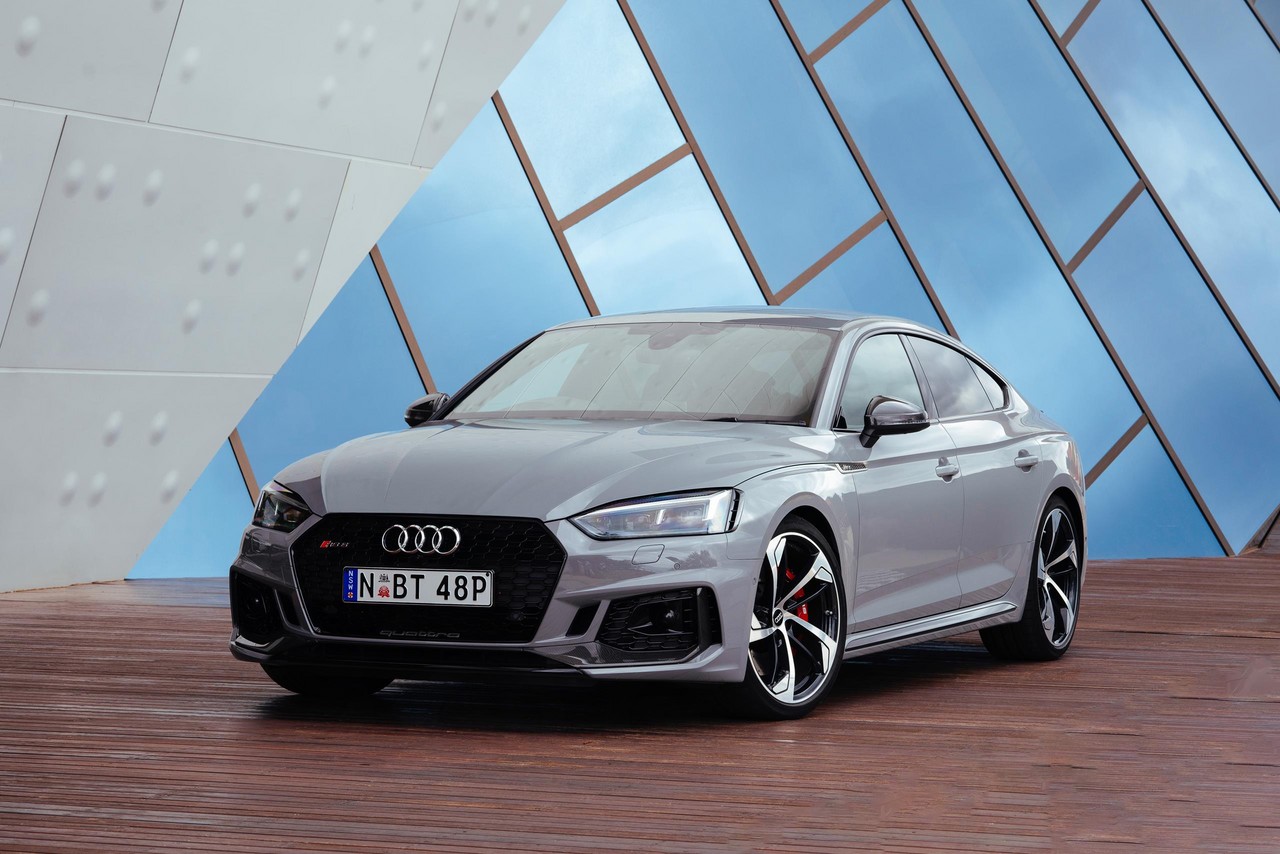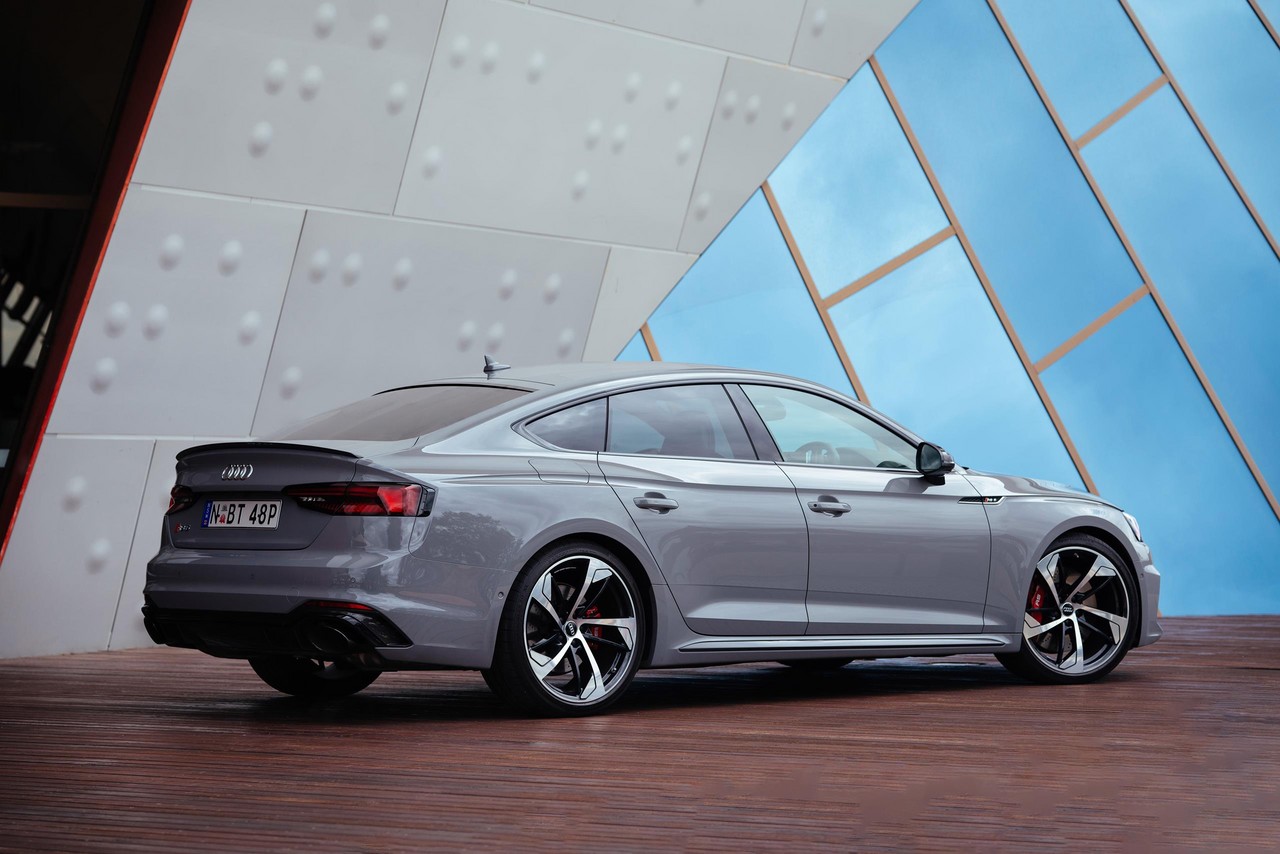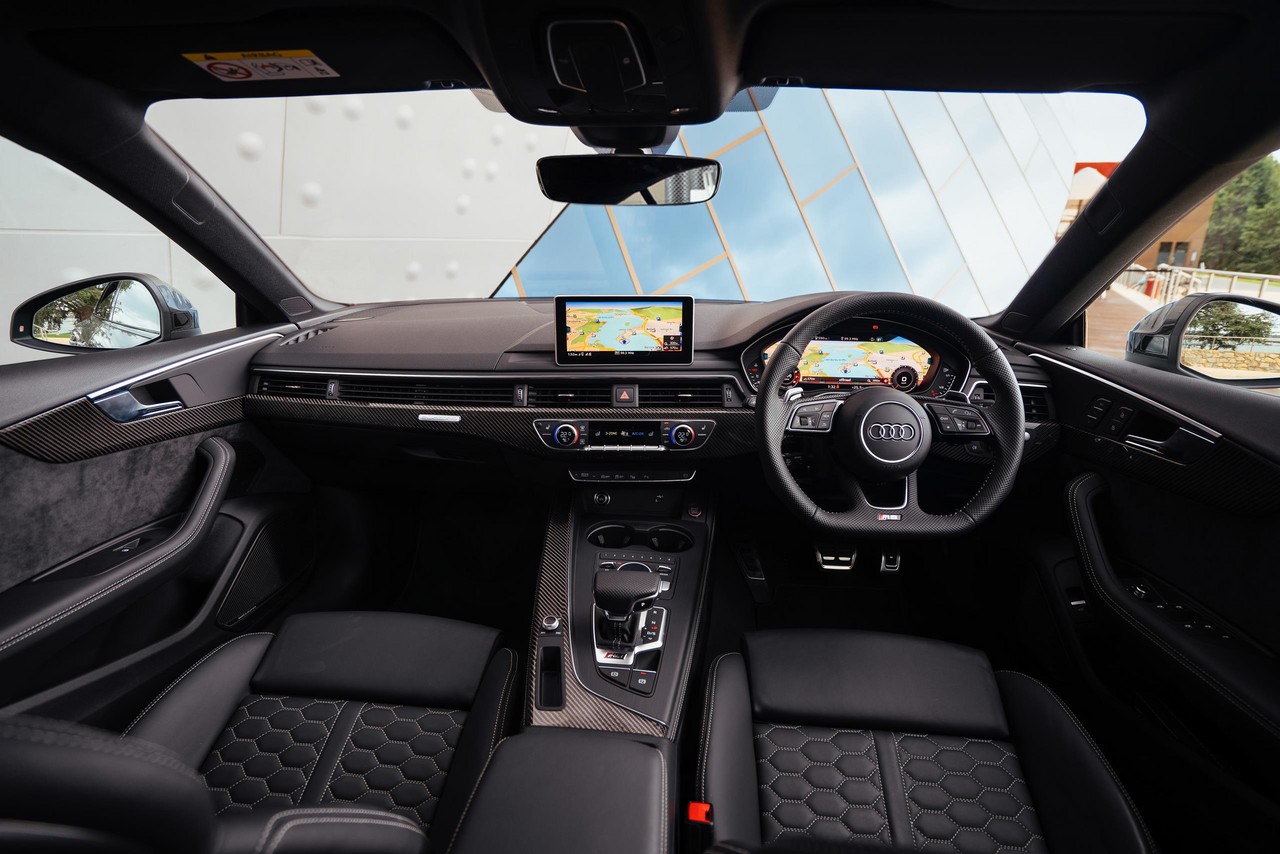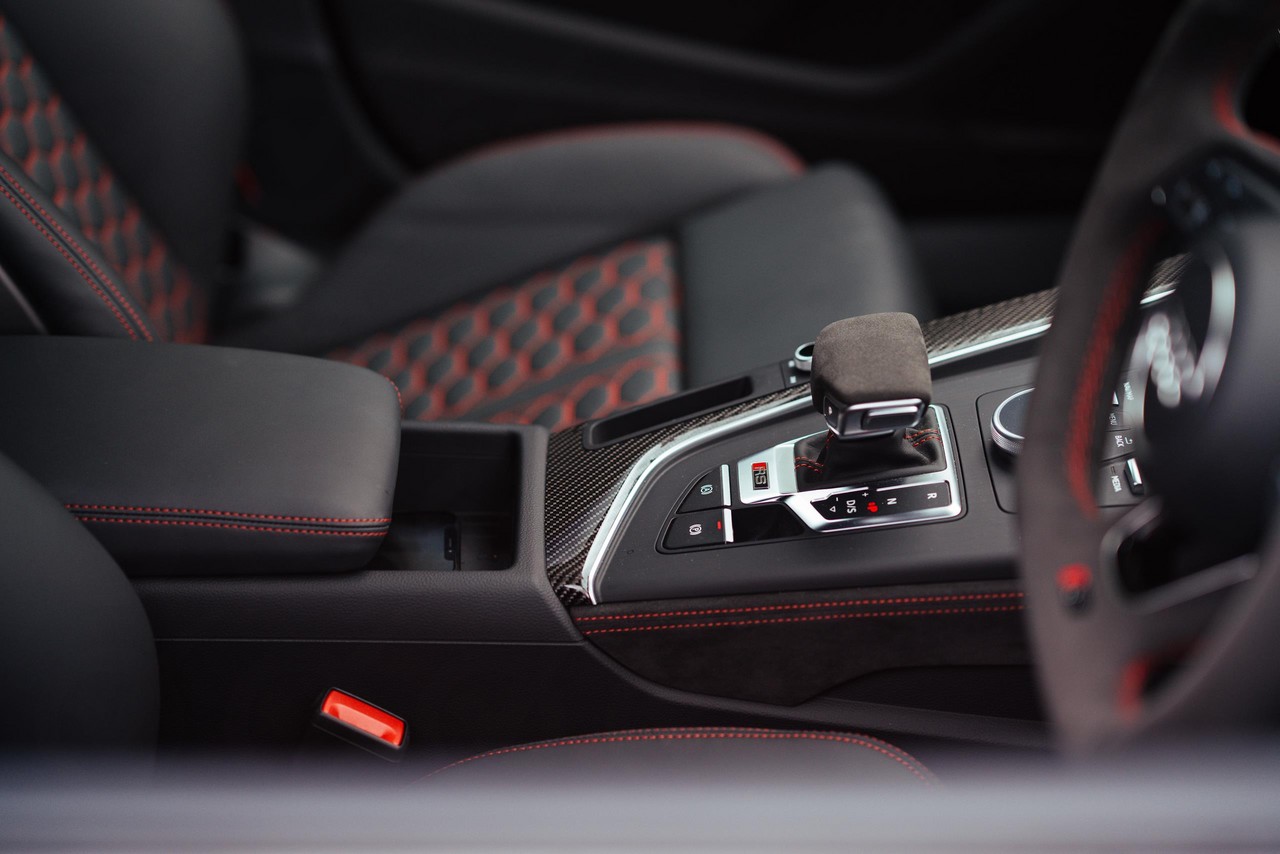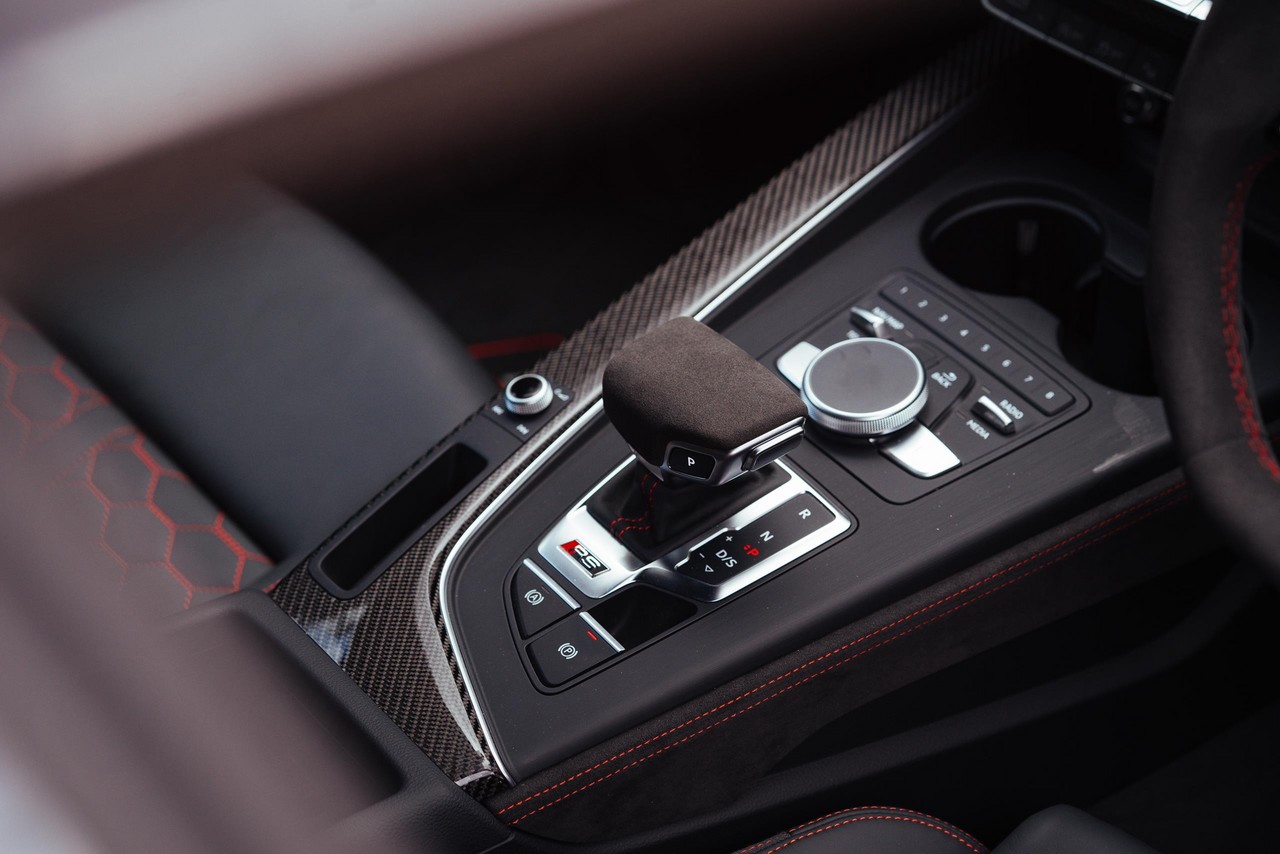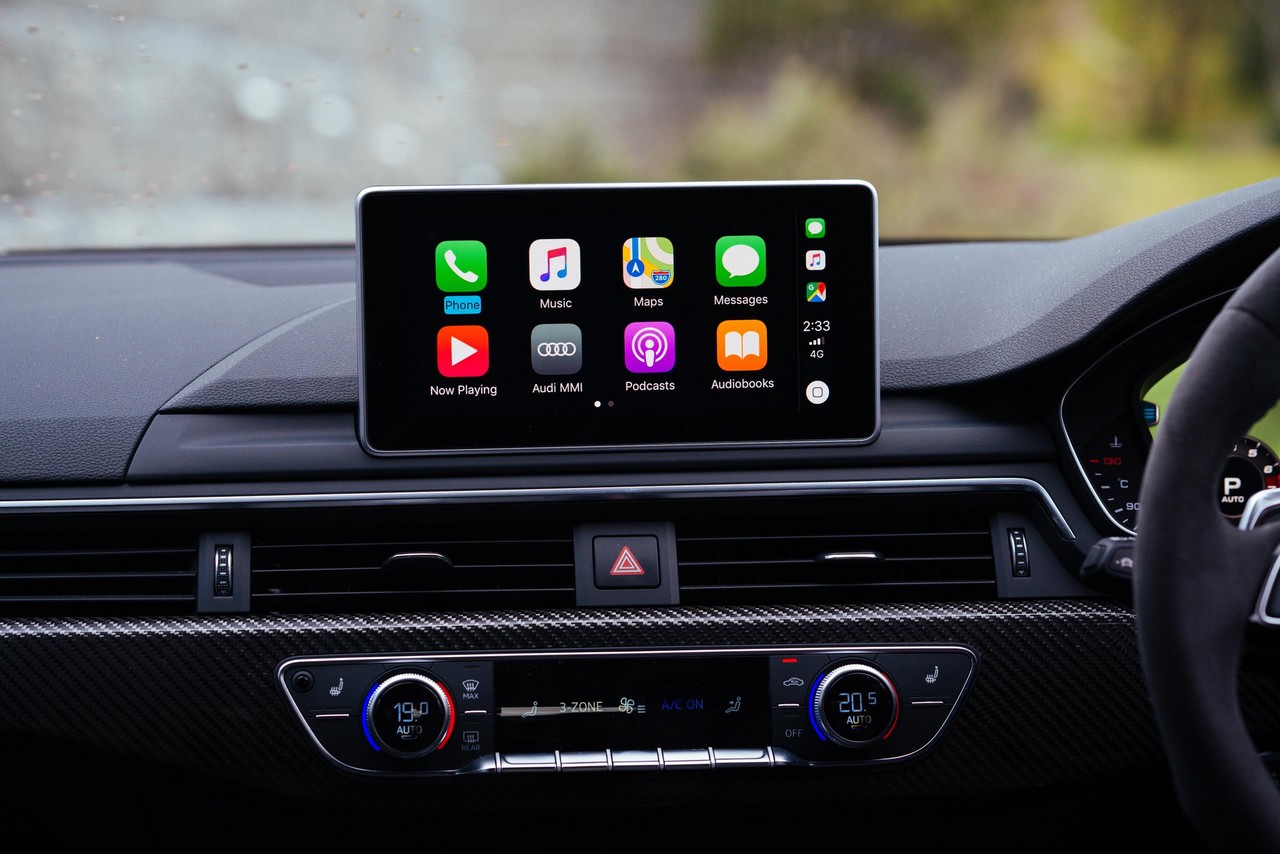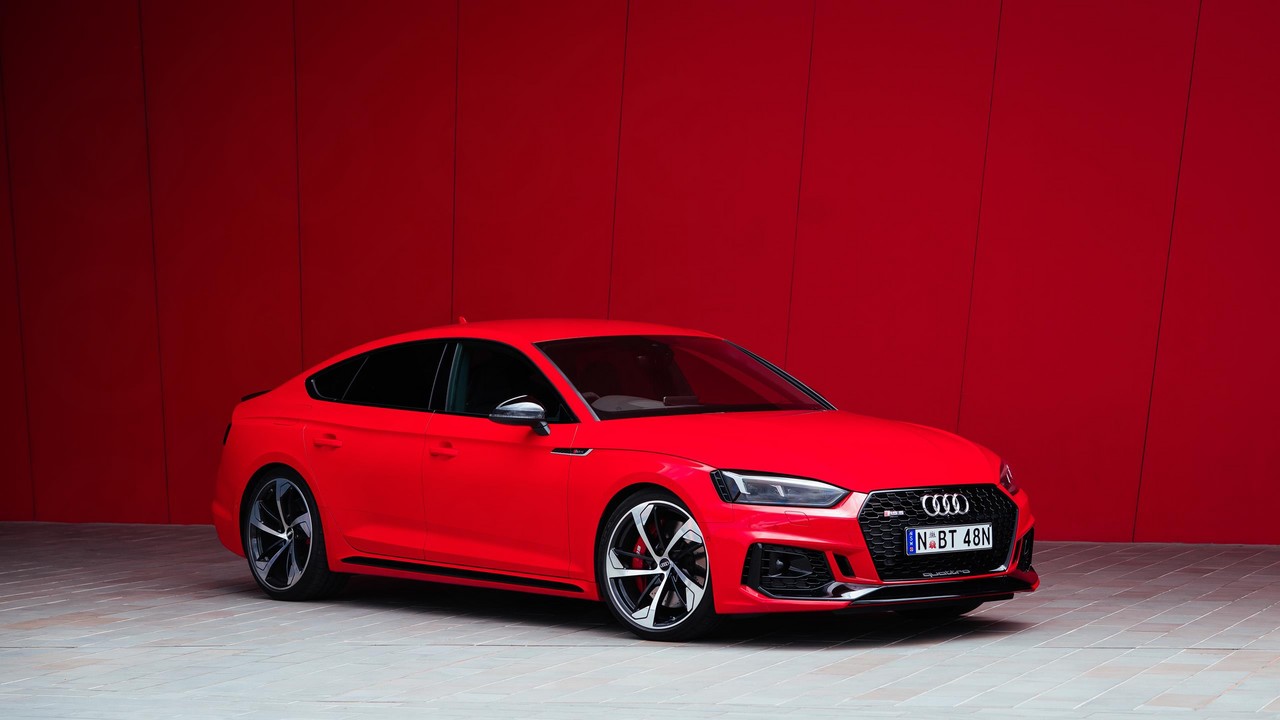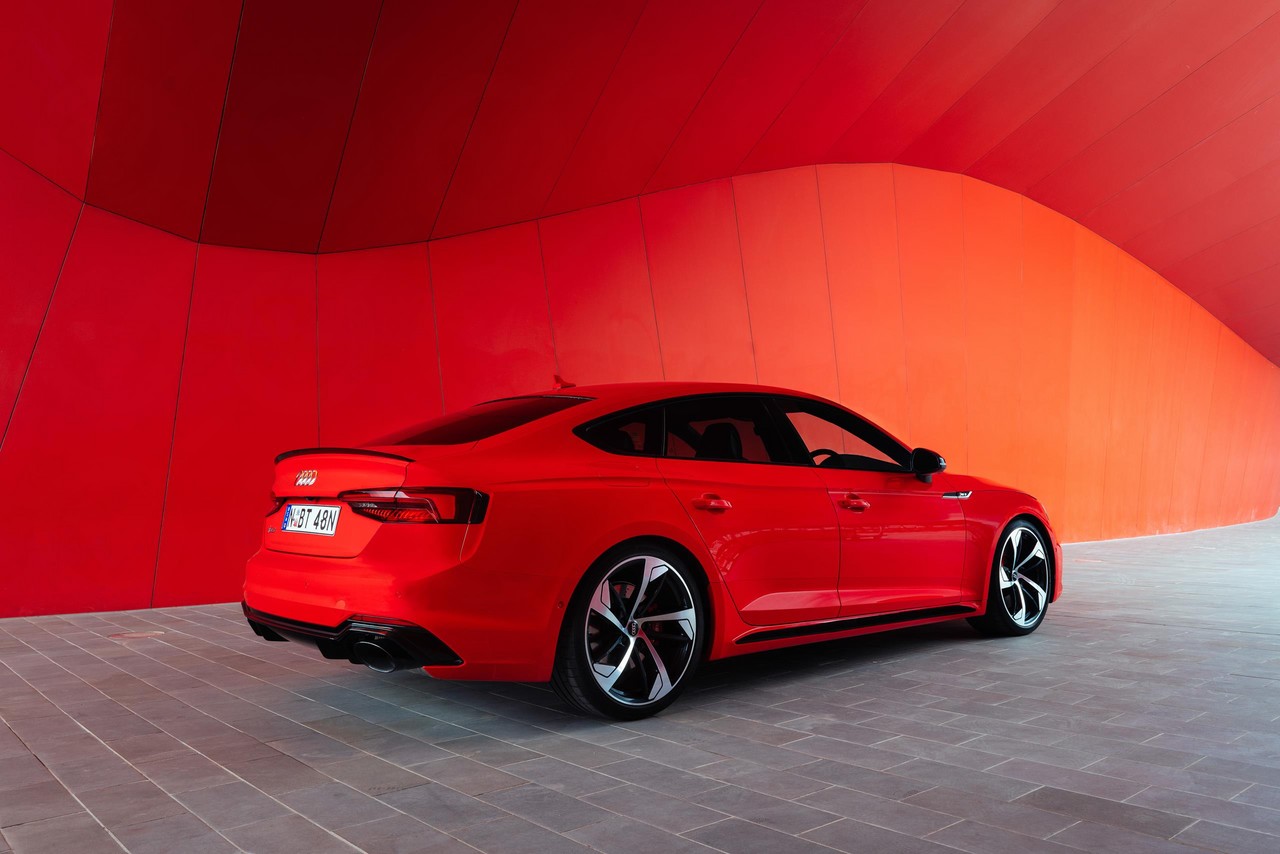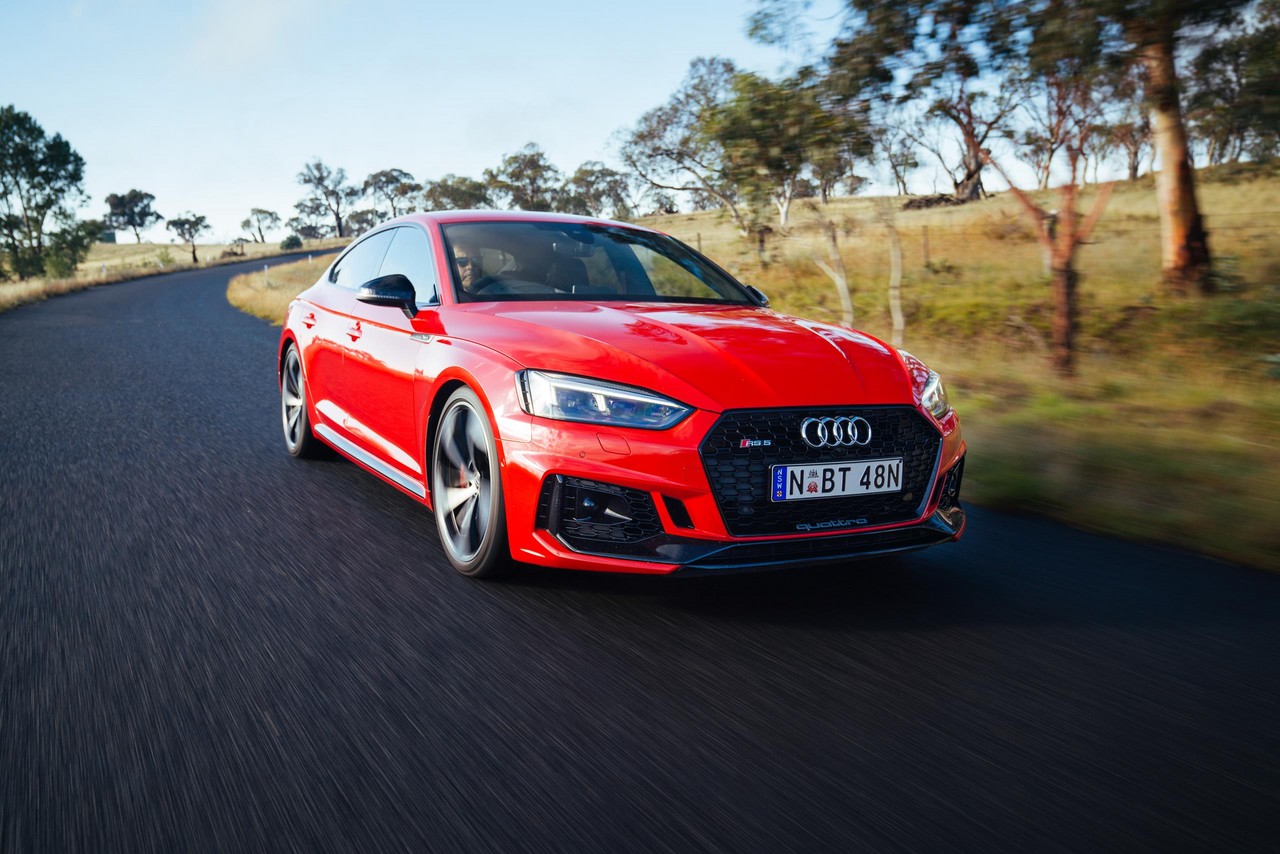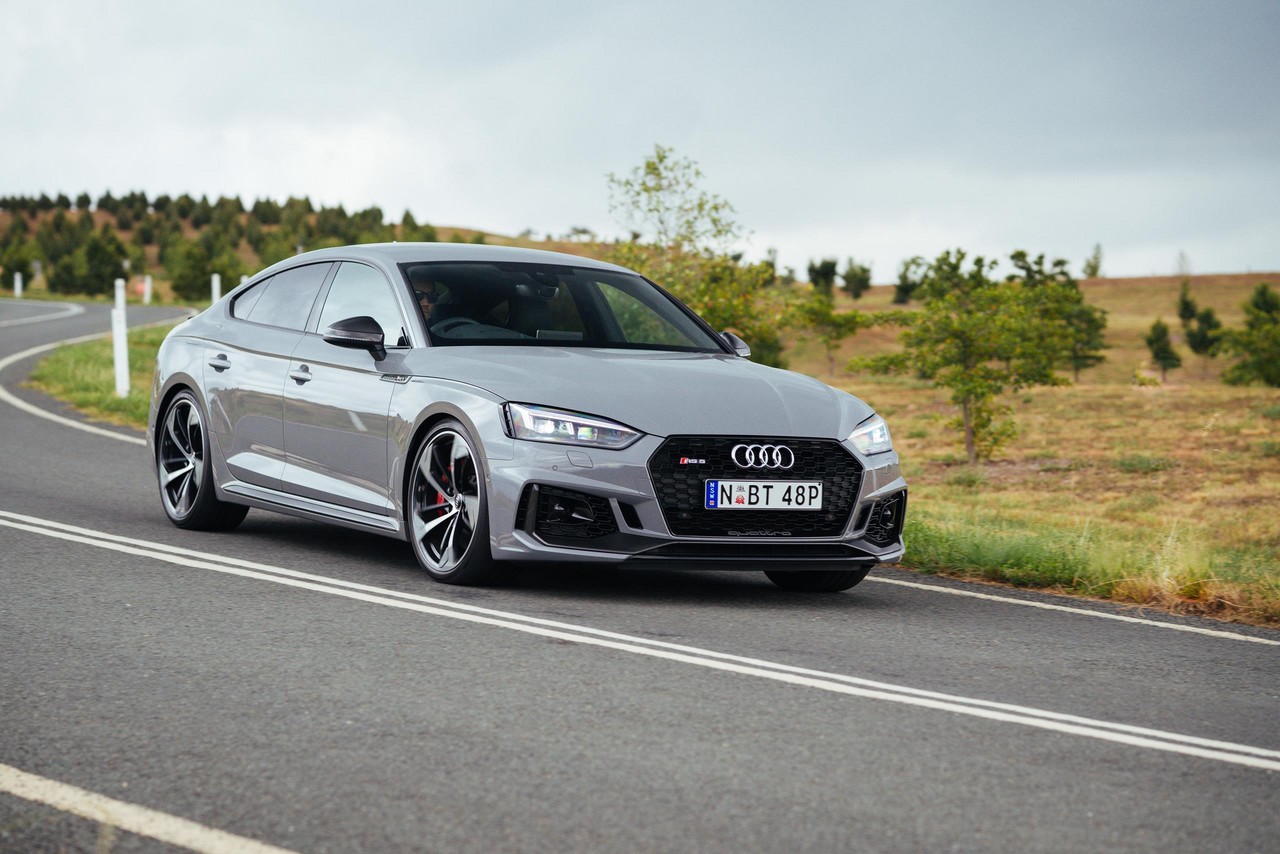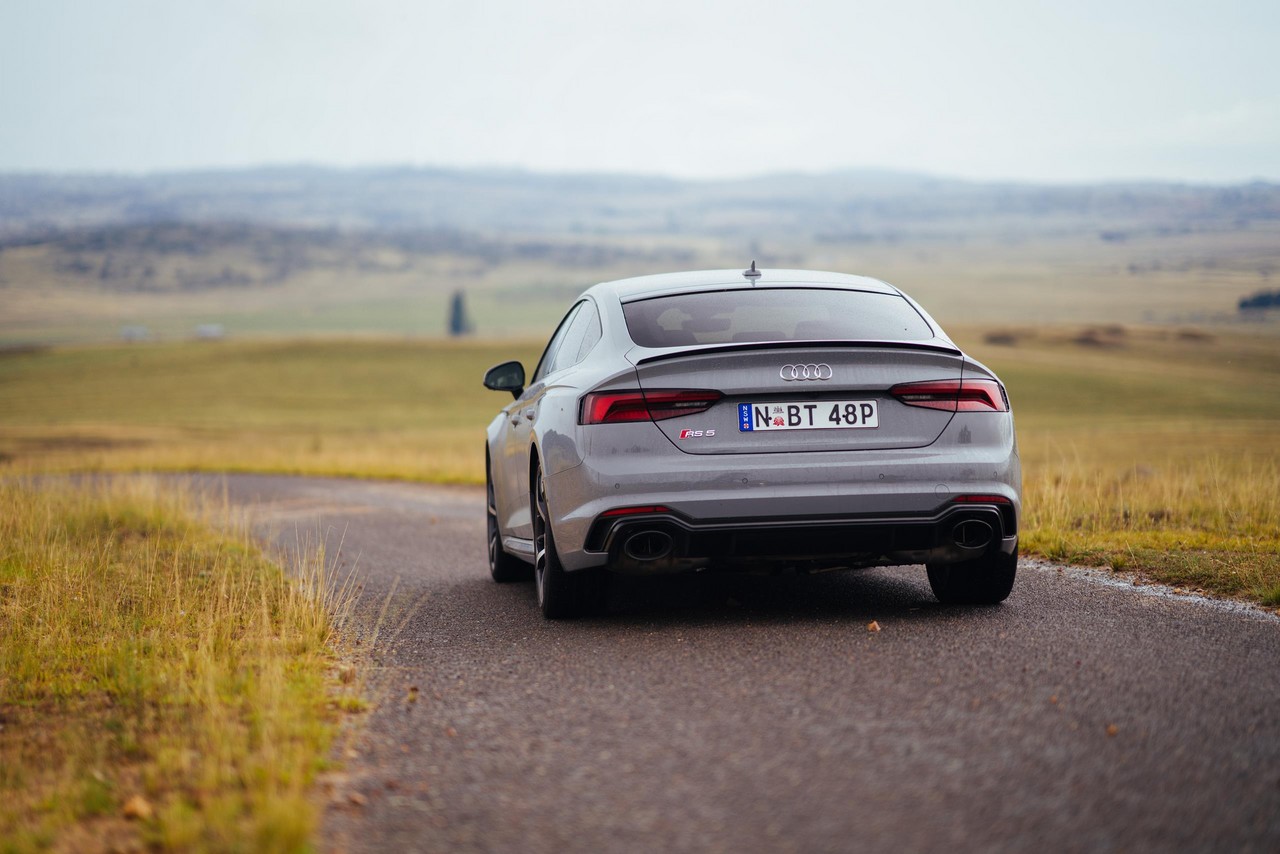
- Powerful 2.9 TFSI biturbo V6 engine
- Refined gearshifts from eight-speed automatic transmission
- Impressive ride/handling balance
- High standard of interior fit and finish
- Supportive front sports seats
- Steering is accurate…
- … though Audi’s ‘dynamic steering’ is counter-intuitive at regular speeds
- Biturbo V6 engine lacks character of Audi’s outgoing 4.2 FSI V8
- Understeer when pushed
- Cramped rear seat headroom
Overview
The Audi F5 RS 5 Sportback was officially released in Australia in February 2019. Manufactured in Germany, the all-wheel drive Audi F5 RS 5 Sportback was powered by a 2.9-litre biturbo V6 petrol engine that was mated to an eight-speed automatic transmission (Audi’s ‘tiptronic’). Upon its release, the Audi F5 RS 5 Sportback had a manufacturer list price of $157,700 (excluded on-road costs such as dealer delivery, registration and insurance).
2.9 TFSI biturbo V6 engine
The Audi F5 RS 5 Sportback’s 2894 cc V6 engine had an aluminium alloy crankcase and cylinder head, thin-walled grey cast iron cylinder liners, double overhead camshafts (chain-driven), four valves per cylinder, variable intake and exhaust valve timing, variable intake valve lift, aluminium pistons, direct injection and a compression ratio of 10.0:1. The engine had two turbochargers – one for each cylinder bank – that were positioned in the engine’s ‘V’ and produced maximum boost pressure of 1.5 bar.
To achieve its high compression ratio and avoid knock (i.e. uncontrolled detonation), the TFSI biturbo engine had a shorter compression phase relative to the expansion phase. According to Audi, the valvelift system enabled shorter intake valve opening times under part loads by closing the intake valves early. At higher loads, however, the inlet valves were actuated via a camshaft contour that provided a longer opening time and increased valve stroke to maximise engine power.
Over the ADR 81/02 test cycle, fuel consumption for the Audi F5 RS 5 Sportback was 8.9 litres per 100 kilometres. Furthermore, the Audi F5 RS 5 Sportback could accelerate from rest to 100 km/h in 3.9 seconds.
| Engine | Trans. | Peak power | Peak torque | |
|---|---|---|---|---|
| Audi F5 RS 5 Sportback | 2894 cc EA839 DEC biturbo petrol V6 | 8sp auto | 331 kW at 5700-6700 rpm | 600 Nm at 1900-5000 rpm |
quattro all-wheel drive system
The four-wheel drive ‘quattro’ system for the Audi F5 RS5 Sportback was a mechanical system which utilised a self-locking central differential (designed as a planetary gear train). In normal conditions, the differential provided 60 per cent of the engine’s torque to the rear axle and 40 per cent to the front, i.e. a 40:60 front:rear torque split. Depending on the situation, however, up to 70 per cent of the engine’s torque can be transferred to the front and up to 85 per cent to the rear.
Wheel-selective torque control and sport differential
As standard, the Audi RS 5 Sportback had ‘wheel-selective torque control’. During ‘dynamic cornering’, wheel-selective torque control could brake the front and rear inside wheels to prevent wheelspin and improve turn-in.
For Australian deliveries, the RS 5 Sportback was equipped with a rear ‘sport differential’ – as standard – that distributed torque between the rear wheels via two superposition gears. In this process, a software function integrated into the central chassis control unit continuously computed the ideal torque split. When turning into or accelerating in a curve, most of the torque would be directed to the outside wheel to generate yaw and reduce understeer.
Body and dimensions
The Audi F5 RS 5 Sportback was underpinned by Volkswagen AG’s ‘MLBevo’ platform. Compared to the Audi F5 RS 5 Coupe , the Audi F5 RS 5 Sportback was 59 mm longer (at 4782 mm), 20 mm narrower (1846 mm), 44 mm taller (1414 mm) and had a 60 mm longer wheelbase (2832 mm). Luggage capacity was 480 litres, though this increased to 1300 litres when the 40:20:40 split/fold rear seats were folded down and luggage was filled to the roofline. Furthermore, the Audi F5 RS 5 Sportback had an unladen weight of 1795 kg.
Suspension and steering
The Audi F5 RS 5 Sportback had five-link front suspension in which the upper links were integrated into the bodywork and the lower links were attached with rubber mounts to a hybrid steel/aluminium sub-frame. For the five-link rear suspension, the axle was insulated from the body by hydraulically damped axle mounts. To reduce mass, the axle links, pivot bearings and damper stilts were made of forged aluminium.
For Australian deliveries, the RS 5 Sportback was fitted with Audi’s ‘Dynamic Ride Control’ (DRC) as standard. With DRC, diagonally-opposed pairs of shock absorbers were linked by hydraulic lines and a central valve. When cornering at speed, the valves regulated oil flow within the shock absorber of the deflected outside front wheel almost immediately, providing greater support and reducing lateral lift. DRC also included three selectable damping settings: comfort, auto and dynamic.
Steering
The Audi F5 RS 5 Sportback had electromechanical power steering in which the level of power assistance was inversely proportional to vehicle speed. As an option, the Audi F5 RS 5 Sportback was available with ‘dynamic steering’ which varied its ratio – by up to 100 per cent – according to the vehicle speed, steering angle and the mode selected in the ‘Audi drive select driving-dynamics’ system.
Safety equipment
Standard safety equipment for the Audi F5 RS 5 Sportback included dual front airbags, front seat-mounted side airbags, full-length curtain airbags (i.e. for front and rear occupants), ABS, electronic brake force distribution, brake assist, electronic stability control, traction control and front seatbelts with pre-tensioners and load limiters.
As standard, the Audi F5 RS 5 Sportback was equipped with the following active safety technologies:
- ‘Audi pre sense city’: operating at speeds up to 85 km/h, Audi pre sense city used a windscreen-mounted front camera to scan the road for other vehicles and pedestrians. If there was a collision risk, the driver received a series of warnings. If the driver failed to respond, full braking force would be applied autonomously. At initial speeds of up to 40 km/h, collisions could be prevented; at higher speeds (up to 85 km/h), the severity of the collision was reduced;
- Audi pre sense front: an extension of ‘Audi pre sense city’, pre sense front operated at speeds up to 250 km/h and could prevent front-to-rear collisions or reduce their severity. In hazardous situations, the driver would receive visual and acoustic warnings to apply the brakes, followed by a brief application of the brakes for a jolting effect to alert the driver. If the driver failed to respond, the RS 5 Sportback would decelerate to the greatest possible extent if the vehicle ahead of it was still moving;
- ‘Audi pre sense rear’: could warn of potential collisions from behind, warn following traffic by rapidly flashing the brake lights and activate the ‘Audi pre sense basic’ protection measures described below;
- ‘Audi pre sense basic’: initiated occupant protection measures such as tightening the front seatbelts, closing the windows and sunroof (where fitted), and activating the hazard lights when ‘unstable driving conditions’ were detected;
- Adaptive Cruise Control (ACC): using two front radar sensors and the camera, ACC could maintain a specified distance – from five distances – between the RS 5 Sportback and the vehicle ahead. Furthermore, ‘Audi drive select’ could be used to adjust the rate of acceleration and other control dynamics;
- Stop&Go function: an extension of the ACC, ‘Stop&Go’ operated at speeds up to 60 km/h to apply the brakes and bring the vehicle to rest. Once traffic began moving, the Audi RS 5 Sportback would automatically accelerates;
- Traffic jam assistant: as part of the ACC, the Traffic jam assistant provided automated steering if traffic was congested and vehicle speeds were below 65 km/h;
- Audi side assist: operating at speeds above 15 km/h, Audi side assist used two rear radar sensors to monitor traffic up to 70 metres behind the RS 5 Sportback. If another vehicle approached quickly or was in the driver’s blind spot, a warning LED in the housing of the appropriate door mirror would illuminate. If the driver activated the indicator to change lanes, the LEDs would blink rapidly to warn the driver;
- Audi active lane assist: used the front camera to detect lane markings when driving at speeds of 65 km/h and above. If the Audi RS 5 Sportback approached a lane marking without the driver having previously indicated, the electromechanical steering would provide an adjustment to bring the vehicle back into its lane. Using the MMI system, the driver could determine whether this system should be active at all times or only before the lane marking is crossed. As an option, the driver could choose to have steering wheel vibrations as a warning signal;
- Collision avoidance assist: activated when the RS 5 Sportback needed to avoid an obstacle to avert a collision. Using data from the front camera, the ACC and radar sensors, ‘avoidance assist’ could calculate the distance of the car ahead, its width and degree of offset. The brakes were then briefly applied to alert the driver of the potential danger and, once the driver started steering, the system would provide ‘support with the necessary lane changes with controlled interventions to the power steering’;
- Rear cross-traffic assist: when reversing at low speeds, rear cross-traffic assist used the rear radar sensors to detect approaching traffic. If approaching traffic was detected which may cross the vehicle’s path, the driver received warnings (visual, acoustic and a brief, jolting application of the brakes);
- Turning assist: active at speeds from 2 km/h to 10 km/h, ‘turning assist’ operated once the driver activated the right-hand turn signal (for RHD vehicles) and could monitor oncoming traffic. In hazardous situations, the brakes would be applied to bring the vehicle to rest;
- Exit warning: activated when the vehicle stopped moving, ‘exit warning’ warned occupants if vehicles were approaching from behind by illuminating red fibre optics in the door-opening mechanism as the doors were opened;
- Multi-collision brake: after a collision, multi-collision brake provided ‘controlled application of the brakes’ to reduce vehicle speed and reduce both the likelihood and severity of subsequent collisions;
- High beam assist: automatically switched between low and high beam headlights for improved visibility, using a sensor to determine when it was safe to do so (i.e. without dazzling other drivers); and,
- Attention assist: monitored driver behaviour and issued a warning if the driver was assessed to be ‘inattentive’.
The Audi F5 RS 5 Sportback also had an ‘active bonnet’ which deployed pyrotechnic charges in the event of a pedestrian collision to raise the height of the bonnet and lock it in position to provide clearance over ‘hard points’ in the engine bay.
Wheels, tyres and brakes
For Australia, the Audi F5 RS 5 Sportback had 9.0J x 20-inch five-arm-trapezoid design alloy wheels with 275/30 R20 tyres. Furthermore, the RS 5 Sportback had 375 mm by 36 mm front perforated composite discs front brake discs with six-piston callipers and 330 mm by 22 mm perforated composite rear discs. As an $11,900 option, the Audi RS 5 Sportback was available with 400 mm by 38 mm high-performance ceramic front brake discs.
Features: Audi F5 RS 5 Sportback
As standard, the Audi F5 RS 5 Sportback was equipped with Audi’s ‘MMI navigation plus’ which included an 8.3-inch high-resolution colour display with 3D maps, integrated voice control, live traffic updates, a CD/DVD player, two SDXC card readers and 10 GB flash memory for media storage, ‘Audi connect’ (in-car Wi-Fi hotspot), Bluetooth interface with music streaming, ‘Audi music interface’ with two USB inputs and auxiliary input socket, and ‘Audi smartphone interface’ for Apple or Android smartphone integration. Beyond this, the Audi RS 5 Sportback had a 755 watt Bang & Olufsen 3D sound system with nineteen (19) speakers and a sixteen-channel amplifier, and a digital radio tuner (DAB+).
Standard features for the Audi F5 RS 5 Sportback also included power adjustable and heated ‘RS’ front sports seats with integrated head restraints and pneumatic adjustment of the side bolsters, driver’s seat massage and memory functions, Fine Nappa leather upholstery, three-zone climate control air conditioning, cruise control with braking, LED headlights with LED daytime running lights, dusk-sensing headlights, rain-sensing wipers, a leather wrapped steering wheel with gearshift paddles, 40:20:40 split and folding rear seats, remote central locking with proximity key (i.e. keyless entry), push-button start, power adjustable and heated door mirrors with folding function, kerb view function for the passenger side door mirror on reverse, an auto-dimming interior rear view mirror, power windows, a height and reach adjustable steering wheel, map lights, interior ambient lighting with thirty (30) selectable colours, stainless steel pedals, floor mats, rear privacy glass, a power-operated panoramic sunroof, tyre pressure monitoring, a trip computer, an alarm and immobiliser.
As standard, the Audi F5 RS 5 Sportback also featured:
- Audi’s ‘virtual cockpit’: a configurable 12.3-inch high-resolution colour display in place of the instrument cluster;
- Audi parking system plus front and rear: front and rear parking sensors, a surround view camera system which provided a 360 degree view of the vehicle, and a visual display;
- Park Assist: automated steering for parallel and perpendicular parking manoeuvres while the driver controlled vehicle speed; and,
- A power-operated tailgate with sensor controlled tailgate release (i.e. could be opened or closed with a kicking motion).
Specifications
